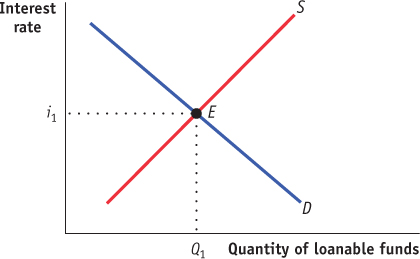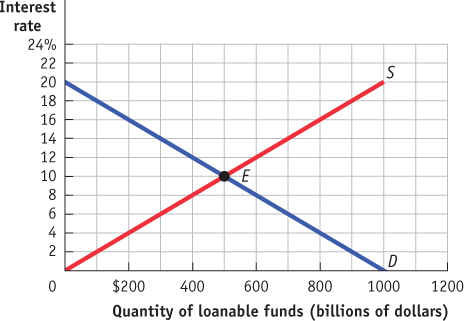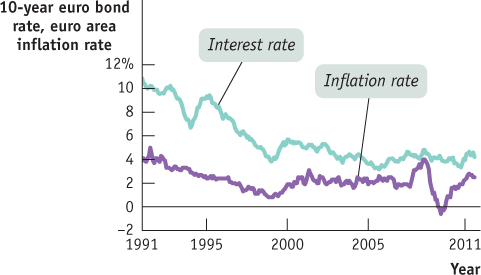10.6 PROBLEMS
Question 10.8
Given the following information about the closed economy of Brittania, what is the level of investment spending and private savings, and what is the budget balance? What is the relationship among the three? Is national savings equal to investment spending? There are no government transfers.

Question 10.9
Given the following information about the open economy of Regalia, what is the level of investment spending and private savings, and what are the budget balance and net foreign investment? What is the relationship among the four? There are no government transfers. (Hint: Net foreign investment equals net exports, or exports minus imports (X − IM).)

Question 10.10
The accompanying table shows the percentage of GDP accounted for by private savings, investment spending, and net foreign investment in the economies of Capsland and Marsalia. Capsland is currently experiencing a negative net foreign investment and Marsalia, a positive net foreign investment. What is the budget balance (as a percentage of GDP) in both countries? Are Capsland and Marsalia running a budget deficit or surplus?

Question 10.11
Assume the economy is open to capital inflows and outflows and therefore net foreign investment equals net exports (X − IM).
X = $125 million
IM = $80 million
Budget balance = −$200 million
I = $350 million
Calculate private savings.
X = $85 million
IM = $135 million
Budget balance = $100 million
Private savings = $250 million
Calculate I.
X = $60 million
IM = $95 million
Private savings = $325 million
I = $300 million
Calculate the budget balance.
Private savings = $325 million
I = $400 million
Budget balance = $10 million
Calculate IM − X.
Question 10.12
The accompanying table, taken from Statistics Canada’s National Income Accounts tables, shows the various components of Canadian GDP in 2009 and 2010 in billions of dollars.

Complete the table by filling in the missing figures.
For each year, calculate taxes (after transfers) as a percentage of GDP.
For each year, calculate national savings and private savings.
Question 10.13
Use the loanable funds market shown in the accompanying diagram to explain what happens to private savings, private investment spending, and the interest rate if each of the following events occur. Assume that there are no capital inflows or outflows.
The government reduces the size of its deficit to zero.
At any given interest rate, consumers decide to save more. Assume the budget balance is zero.
At any given interest rate, businesses become very optimistic about the future profitability of investment spending. Assume the budget balance is zero.

Question 10.14
The government is running a budget balance of zero when it decides to increase education spending by $200 billion and finance the spending by selling bonds. The accompanying diagram shows the loanable funds market before the government sells the bonds. Assume that there are no capital inflows or outflows. How will the equilibrium interest rate and the equilibrium quantity of loanable funds change? Is there any crowding out in the market?

Question 10.15
Suppose a national early childhood education program for all preschool-
Draw typical demand (D1) and supply (S1) curves for loanable funds without accounting for the cost of any government measures to fund the education program. Label the vertical axis “Interest rate” and the horizontal axis “Quantity of loanable funds.” Label the equilibrium point (E1) and the equilibrium interest rate (i1).
Now draw a new diagram with the cost of the government measures to fund the education program included in the analysis. Shift the demand curve in the appropriate direction. Label the new equilibrium point (E2) and the new equilibrium interest rate (i2).
How does the equilibrium interest rate change? Explain.
Question 10.16
Explain why equilibrium in the loanable funds market maximizes efficiency.
Question 10.17
How would you respond to a friend who claims that the government should eliminate all purchases that are financed by borrowing because such borrowing crowds out private investment spending?
Question 10.18
Boris Borrower and Lynn Lender agree that Lynn will lend Boris $10 000 and that Boris will repay the $10 000 with interest in one year. They agree to a nominal interest rate of 8%, reflecting a real interest rate of 3% on the loan and a commonly shared expected inflation rate of 5% over the next year.
If the inflation rate is actually 4% over the next year, how does that lower-
than- expected inflation rate affect Boris and Lynn? Who is better off? If the actual inflation rate is 7% over the next year, how does that affect Boris and Lynn? Who is better off?
Question 10.19
Using the accompanying diagram, explain what will happen to the loanable funds market when there is a fall of 2 percentage points in the expected future inflation rate. How will the change in the expected future inflation rate affect the equilibrium quantity of loanable funds?

Question 10.20
The accompanying diagram shows data for the interest rate on 10-year euro area government bonds and inflation rate for the euro area for 1991 through mid-

Question 10.21
For each of the following, is it an example of investment spending, investing in financial assets, or investing in physical assets?
Rupert Moneybucks buys 100 shares of existing Coca-
Cola stock. Rhonda Moviestar spends $10 million to buy a mansion built in the 1970s.
Ronald Basketballstar spends $10 million to build a new mansion with a view of the Pacific Ocean.
Rawlings builds a new plant to make catcher’s mitts.
Russia buys $100 million in Canadian government bonds.
Question 10.22
Explain how a well-
Question 10.23
What are the important types of financial intermediaries in the Canadian economy? What are the primary assets of these intermediaries, and how do they facilitate investment spending and saving?
Question 10.24
Explain the effect on a company’s stock price today of each of the following events, other things held constant.
The interest rate on bonds falls.
Several companies in the same sector announce surprisingly higher sales.
A change in the tax law passed last year reduces this year’s profit.
The company unexpectedly announces that due to an accounting error, it must amend last year’s accounting statement and reduce last year’s reported profit by $5 million. It also announces that this change has no implications for future profits.
Question 10.25
Suppose HSBC Canada were to package individual student loans into pools of loans and then sell shares of these pools to investors as HSBC student loan bonds.
What is this process called? What effect will it have on investors who previously could only buy and sell individual student loans?
What effect do you think HSBC’s actions will have on the ability of students to get loans?
Suppose that a very severe recession were to occur, and, as a consequence, many graduating students could not get jobs and then had to default on their student loans. What effect would this have on HSBC student loan bonds? Why is it likely that investors would now believe HSBC student loan bonds to be riskier than expected? What will be the effect on the availability of student loans?